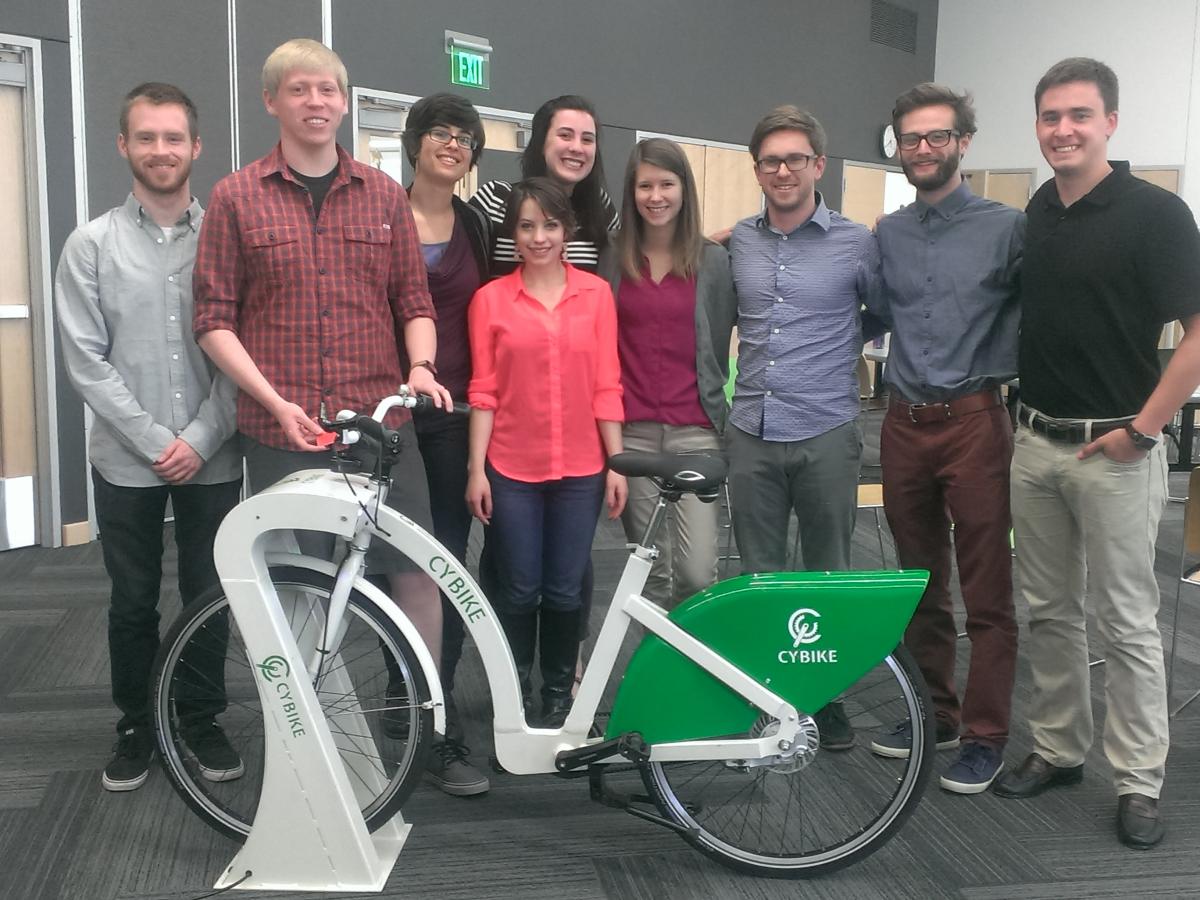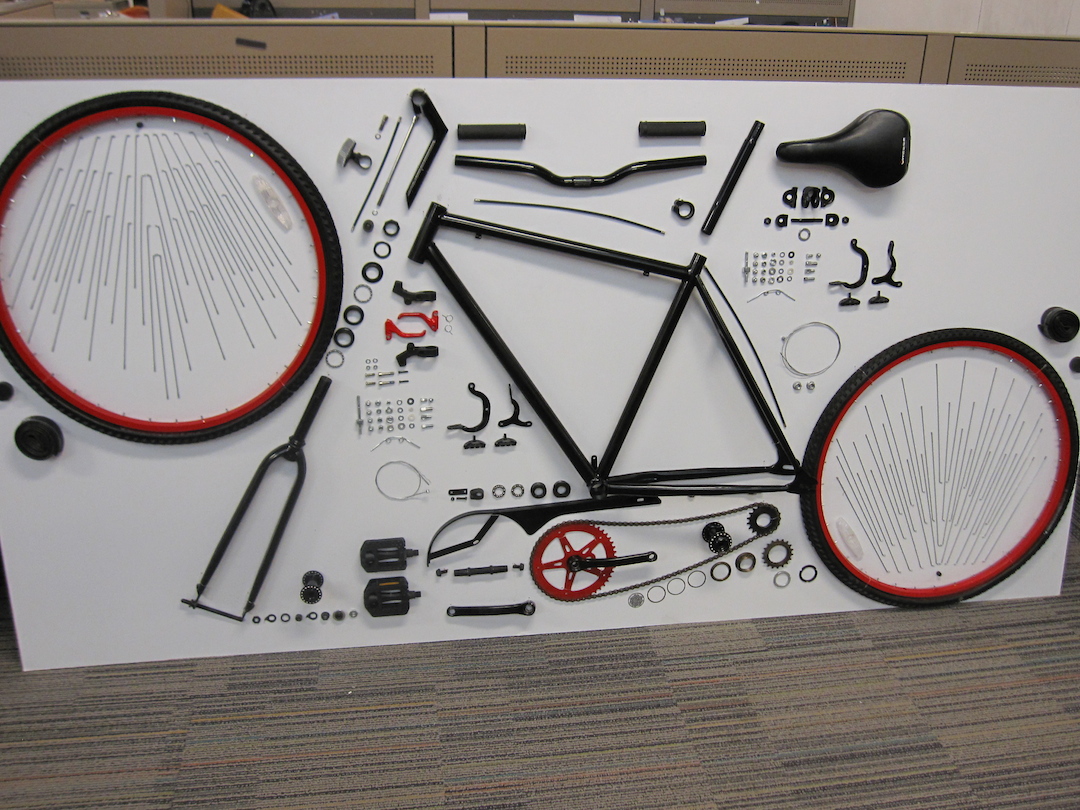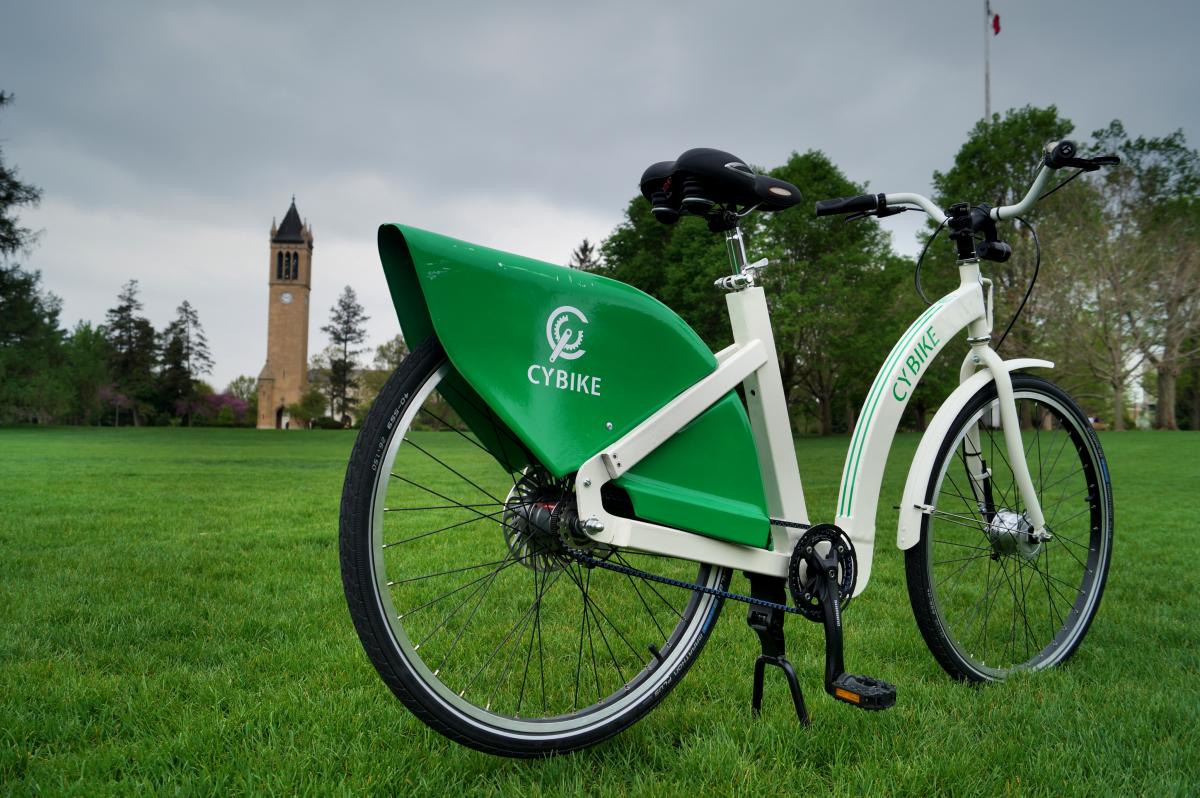DISCOVER YOUR LOCAL BICYCLING COMMUNITY
Find local advocacy groups, bike shops, instructors, clubs, classes and more!
University Students Build Their Own Bike Share
Iowa State University received an honorable mention in today’s Bicycle Friendly University awards. In the Fall 2015 issue of our American Bicyclist magazine, we showcased an inspiring story from ISU. Mark Kargol, a Lecturer in the Department of Industrial design at ISU, shared the evolving story of Cybike — a campus bike share system conceived and created entirely by students.
 The spokes began to align in 2013. That spring, Jordan Maurice, a senior in industrial design, conducted a transportation study of the Iowa State University (ISU) campus as his senior project. With real-world implications for his fellow Cyclones, he presented his findings to the Government of the Student Body (GSB) and school administrators. Lo and behold, just a few months later, the President of the GSB added a bike share project to the list of sustainability initiatives for ISU.
The spokes began to align in 2013. That spring, Jordan Maurice, a senior in industrial design, conducted a transportation study of the Iowa State University (ISU) campus as his senior project. With real-world implications for his fellow Cyclones, he presented his findings to the Government of the Student Body (GSB) and school administrators. Lo and behold, just a few months later, the President of the GSB added a bike share project to the list of sustainability initiatives for ISU.
Of course, as Maurice’s research showed, a bike share system would address more than environmental stewardship. Enrollment had increased by nearly 6,000 students (16%) since Maurice’s initial study and the campus was facing overcrowding issues. And, with more people traveling by bike and on foot, boosting safety for pedestrians and cyclists had become a key priority, as well.
But the school took an innovative path to making that vision a reality. Rather than hiring a consultant or looking to outside vendors, ISU brought together dozens of students in a number of different disciplines to conceive, design and build a bike share system of their very own — from scratch.
Rather than hiring a consultant or looking to outside vendors, ISU brought together dozens of students in a number of different disciplines to conceive, design and build a bike share system of their very own — from scratch.
Building on a rich history of bicycling
In the 1970s and 1980s, Ames, Iowa, was home to the Raleigh/Levi cycling team based out of Michael’s Cyclery, producing riders like Andy Hampsten, Connie Carpenter, and Steve Tilford. Michael’s Cyclery also provided mechanics for the 1984 Olympics.
Recently, a trail network has been built around central Iowa with more than 600 miles, including the High Trestle Trail. And, of course, any talk about bicycling in Iowa has to include RAGBRAI, which has included Ames along its route four times. This history, and a campus where students are looking for convenient ways to get around, has created a very active cycling environment.
The Industrial Design Department led the charge to engage that excitment in the academic setting to create real-world results. The department proposed to top administrators a studio class to design the bike share system for campus. We found the administration and facilities on campus had been discussing many of the topics that we addressed in the class — but didn’t have the answers. By bringing these problems to the students they were able to develop practical solutions and invest in improving the campus for the future.
A bike share built by and for Cyclones
In that first semester, we set the framework for everything that would come after. We worked alongside the students but asked them to research existing bike share systems and find out what is working well and what the problems are.
To help with this we brought in industry experts from SRAM, Salsa, and All-City Cycles. Students visited the QBP headquarters in Bloomington, MN, and the SRAM headquarters in Chicago, IL, giving them the chance to speak face-to-face with designers, engineers, and product managers about ideas they had for the ISU Bike Share system.
The biggest surprise for me was the students overall lack of experience working with or even thinking about bicycles. Each semester the students would have to take several weeks just getting oriented with how a bicycle works and the parts necessary.
Initially, the bicycle seems to be a pretty simple machine, but it’s the complexity of the bicycle that makes it a really great area for students to study.
Initially, the bicycle seems to be a pretty simple machine, but it’s the complexity of the bicycle that makes it a really great area for students to study. You have motion, structures, friction, dynamic and static loading, aesthetics, and ergonomics — add in electronics and networking for the bike share and students get a manageable but complex problem to be solved. This fits well with an academic structure and the 16 weeks of a semester.
By the end of that first semeter, the first group of students had identified issues with current systems, and proposed some great solutions for problems that all bike share systems face. They then created three conceptual bicycle and dock designs, completed initial planning for locations and quantities, and sketched out phone app designs.
In Fall 2014, it was time to bring in students from other departments to round out the effort. Students from mechanical engineering, electrical engineering, computer engineering, computer science, and community and regional planning joined the project.
Cycles of collaboration
Giving students the opportunity to work on a real-world project with students from a wide range of majors caused some growing pains at first, as students discovered that not everyone works or communicates in the same way. But, by the end of each semester, the students were able to effectively communicate and work alongside each other regardless of their major to realize their place in the process and the interdependence to develop the bike share system to where it is today.
One of the students commented that he has had four internships and this class taught him more about working in the real world than any of those internships. That says a lot about the value of this project in the academic development of the students involved.
It was also critically important for all of the teams to work together without preconceptions of ego and stereotypes of what an industrial designer or engineer is like. All teams and individuals had to respect the experience and knowledge of the others.
As for the instructors, we had to keep tabs on the teams. We had to let them mess up. But we also had to keep them on task. To do that we constantly emphasized that this is a system within a larger system. It takes everyone — and everyone has to leave thier ego at the door because the leading team will change as the project matures.
Bringing it all together
In the second semester, students started to work on the nuts and bolts of the system itself, with different departments tackling critical tasks within their field.
 Mechanical Engineering Department
Mechanical Engineering Department
- Took several ideas and designs from the previous semester and brought them together into a working bicycle.
- Evaluated two of the frame designs based on strength and manufacturability.
Electrical Engineering
- Worked on electronics to make the bike share locking mechanism, and check-out system.
- Ensured the power supply would work on a single dock module rather than being linked to a kiosk, allowing the system to be scaled at any location by adding or subtracting any number of docks.
- Explored various power sources for the docking stations, including solar power, to allow stations to be installed in remote areas where power may not be available.
Community & Regional Planning
- Completed a comprehensive evaluation of campus bicycling conditions and created a detailed analysis of docking station locations, and quantities of bikes and docks.
- Conducted a multi-phase plan for improvement of bicycle infrastructure on campus, including a proposed dedicated 15-foot-wide bike-ped pathway running across campus, bike boxes at intersections, repainting of sharrows, new signage, extension of existing bike paths, and removal of on-street parking on one of the most congested roads on campus to allow for a dedicated two-lane bike path. This became a document with more than 300 pages!
Computer Science
- Created a software specification for the administrative side of the system, and the phone app.
Computer Engineering
- Developed software allowing the tracking of bicycles, dock information, and user information for accountability of the bikes.
- Created software to interface with the campus wireless internet system, creating a secure means of data transfer, and the administrative interface of the software.
Mechanical Engineering
- Worked on the docking station design — including the interface between the dock and the bike — and created an innovative locking mechanism that allows for the bike to be returned to a station even if the stations are out of service due to a power outage.
Seeing Results
 The third semester of work began in January 2015. This class built on the work of the previous two semesters to refine and prototype a production-ready system. This system incorporates the physical requirements, materials, component specifications, working electronics, software, bikes, dock, and other items to bring this to reality.
The third semester of work began in January 2015. This class built on the work of the previous two semesters to refine and prototype a production-ready system. This system incorporates the physical requirements, materials, component specifications, working electronics, software, bikes, dock, and other items to bring this to reality.
Students also developed a complete streets policy and design guide for the City of Ames and the Iowa State University Campus, planned a regional bicycle summit, and designed and constructed a bike shelter on campus made entirely from recycled materials. In addition, students worked with university personnel to complete the League’s Bicycle Friendly University application.
Thanks to the commitment of the students and faculty to this project and its impact on sustainability on campus, the program received the 2014 Live Green Award for Excellence in Sustainability for Exceptional Leadership in Sustainability from Iowa State University.
Now, moving into the fourth semester of the project this fall, our focus is taking the working prototype that was developed in the spring semester and addressing some of the potential problems we’ve identified — and revising the hardware for production. The students are also further developing the software to incorporate a full stack of analytics and developing the mobile app for users of the system.
Benefits for ISU — and beyond
The classes have produced some really great work. From initial concept development, phone applications, and redistribution planning, to the engineering and design of a bicycle that rides beautifully and, despite its weight, has riders commenting about how light it is. From a complete streets policy and campus infrastructure improvement plan, to a fully operational docking station with electronic lock, cloud-based software, and an RFID checkout system that interfaces with the bicycle. It’s all an amazing accomplishment for students over a four-semester timeline.
The students at ISU love the school and the campus, and the opportunity to do this project has motivated them to produce professional-level solutions and documentation that will be used in future years to shape the campus.
This summer we were approached by the Iowa State University Research Park to discuss the possibility of a bike share on its campus. The University research park is in the midst of a 200-acre expansion that will include a 40-acre park and several new buildings. This park will include bike trails that will provide a critical link between Ames and the High Trestle Trail.
We are currently working on securing funding to have a pilot project operating when two new buildings open at the research park. This phase of the project will focus on providing a quick and convenient way to travel throughout the research park and to and from the main ISU campus. With talent being the No. 1 motivation for companies to locate in the research park, an efficient way for students to travel from campus to the research park is very important. Depending on funding, it’s our desire to expand the system, not only throughout the ISU campus, but the City of Ames, as well.
The students at ISU love the school and the campus, and the opportunity to do this project has motivated them to produce professional-level solutions and documentation that will be used in future years to shape the campus.
Photos provided by Mark Kargol